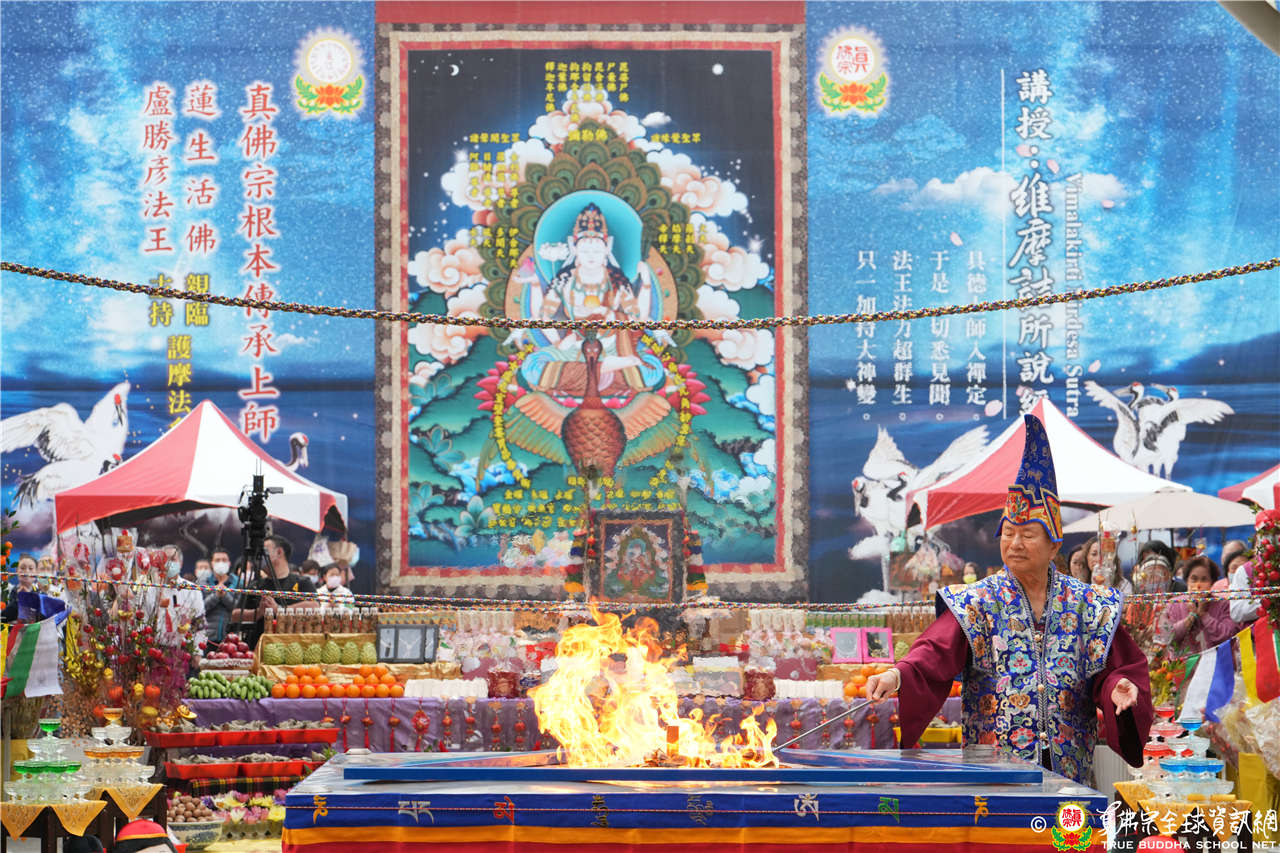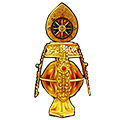
Vimalakirti Nirdesa Sutra
A Detailed Exposition by Living Buddha Lian Sheng, Grandmaster Sheng-Yen Lu
Translated into English by the True Buddha School Vimala Sutra Translation Team
Discourse 57, 7 January 2023 - Chapter One—Buddhaverse (Continued)
Chapter One—Buddhaverse
As such, the assembly witnessed a miraculous display of the Buddha’s divine power in a way they had never seen before. They joined their palms with reverence, paid homage, and their gazes were fixated on it.
Then, the elder, Accumulated Treasures, spoke this verse to praise the Buddha:
The one with pure eyes who cultivates like a blue lotus.
His pure mind has transcended all meditations.
Let’s now talk about the Vimalakirti Sutra.
As such, the assembly witnessed a miraculous display of the Buddha’s divine power in a way they had never seen before. They joined their palms with reverence, paid homage, and their gazes were fixated on it.
Everyone in the assembly witnessed Sakyamuni Buddha manifesting his transcendent power to gather and transform all the parasols into one parasol. Not only that, but they also witnessed the three-thousand-great-thousand worlds, and all the buddhaverses in the ten directions with the buddhas speaking dharma under the parasol. They all marveled at the sight as they have never seen anything like it before. They were amazed and deeply moved, and they joined their palms and paid homage to the Buddha.
…their gazes were fixated on it.
Their wide-open eyes could not move away from Sakyamuni Buddha’s face, as if they were glued to it.
Then, the elder Accumulated Treasures spoke this verse to praise the Buddha.
A verse is the same as a praise. Usually, they translate the Sanskrit “gatha” as “verse.” Sometimes we call it a poem—we use a poem to praise. Chinese [classical] poems are typically in a five or seven-character line. So gatha, verse, praise, and poem are all the same.
Now onto the Accumulated Treasures Bodhisattva offering a praise. Of course! Because Sakyamuni Buddha was truly remarkable! He transformed the five hundred parasols into one parasol that could contain the three-thousand-great-thousand worlds and even the buddha worlds where all buddhas were speaking dharma. Truly amazing! Sakyamuni Buddha was indeed incredible.
Meanwhile, Grandmaster is just like a very small potato. All Grandmaster manifested was one parasol that covered the Taiwan temple. So miniscule. One time, when I asked Mahamayuri to extend his wings to block the sun from scorching us, immediately two clouds appeared out of nowhere to provide shade for the assembly. Wow! We then felt a lot cooler. That alone was already amazing.
By comparison, Sakyamuni Buddha’s transcendent power was much more remarkable. Everybody in that ceremony witnessed all the buddhas speaking dharma under the parasol. That is true transcendental power.
The elder Accumulated Treasures Bodhisattva spoke the following verse to the Buddha:
“The one with pure eyes who cultivates like a deep blue lotus.”
The simple explanation is that Sakyamuni Buddha’s eyes are pure and boundless like a deep blue lotus. They used the deep blue lotus to symbolize Sakyamuni Buddha’s pure eyes.
“His pure mind has transcended all meditations.”
The Buddha’s mind is pure and he has experienced and transcended all forms of meditation. Once you attain empty-nature, you have attained buddhahood. By then of course, you would have transcended all forms of meditation.
There are many forms of meditation. One form of meditation that we often mention is Vajravarahi’s bliss meditation, where you enter meditation through desire and bliss. In Tantrayana, the initial stage of meditation is concentration (single-mindedness). The second step is to renunciate (abandon) the games of the mundane world.
What do we do in this saha world? To play around [since life is like a game/play.] What do you do with your cellphones? Play! Play games! Let me tell you playing games is very poisonous and many people have been poisoned by cellphones [or the internet]. Most people “play” with their phones—checking the stock market, et cetera [also a kind of play in the mundane world]. Not much real work. There is buddhadharma too on the cellphones. Anyone using it for buddhadharma? [A few people in the audience respond.] Did you say you use it to watch Grandmaster’s discourses? Amitabha! Researching buddhadharma online? And reading the Vimalakirti Sutra? If that’s the case, then you have renounced the games of the world. In the meditation of renunciation, one has renounced playing in the game of life.
The next level is the meditation of one taste or the meditation of unity. Who are you in union with? With the yidam—meditational deity, with the one you take refuge in, but most importantly, with the consciousness of the universe or the empty-nature. That’s the meditation of one taste. In this meditation, there is only one kind of taste, and not two.
In this saha world, everything has dual taste and nothing is of one taste: If there is heaven, there is hell; there are good and bad, beautiful and ugly, fragrant versus foul, and so on. Everything is dualistic. However, when you are in union in the yoga of one taste, everything becomes one taste. This is the third kind of meditation.
Another kind of meditation is called the meditation of no-practice, where you don’t need to practice anymore. You have abandoned all dharma since you no longer need them. You just follow affinity with great self-mastery. Not practicing is the same as practicing, as you follow affinity with great self-mastery. When you have truly proven the empty-nature, you have reached the meditation of no-practice. And this is the highest kind of meditation.
Each kind of meditation is again divided into many more kinds of meditation. Sakyamuni Buddha’s pure mind has transcended all forms of meditation. Thus, he is a buddha, in the state of no-practice. With self-mastery, he acts spontaneously according to affinity. What does this mean: spontaneous activities following affinity with self-mastery?
Is there a buddha in the saha world? Yes. Sakyamuni Buddha. Are there bodhisattvas? Of course, Vimalakirti was a bodhisattva. Are there arhats? Yes, Sakyamuni Buddha’s ten main disciples were all arhats—they have attained arhatship. How about pratyekabuddhas? Yes, Jesus was one of them. So many beings from the four sagely realms are in samsara. The saha world is a combination of many kinds of realms, so I’d call it a combo land. You’ve never heard of this term before because I just invented it. What else would I call it? [laughing]
The Heart Sutra clearly states that it is neither defiled nor immaculate. The Accumulated Treasures Bodhisattva has not reached that state, because by saying “pure” eyes and “pure” mind, he was still mindful of “purity” instead of being free from the [notion] of both purity and impurity.
In fact, Sakyamuni Buddha is neither defiled nor immaculate. Once you enter empty-nature, only the empty-nature is pure. [In emptiness,] there is nothing, and there is no such thing called “purity.” [Only empty-nature can be called pure, and nothing else.] Because it is indescribable, Accumulated Treasures Bodhisattva can only use “pure” eyes and “pure” mind to describe. If we want to talk about pure eyes and pure mind, a whole day might not be enough.
What are pure eyes? To explain pure eyes, I need to first talk about the five kinds of eyes a buddha has: physical eyes, divine eyes, dharma eyes, wisdom eyes, and buddha eyes. Do you have buddha eyes? Do you have wisdom eyes? Do you have dharma eyes? Do you have divine eyes? We all have physical eyes but not the other kinds of eyes. The buddhas have all five kinds of eyes.
What are dharma eyes? They’re the eyes that can discern all differences. They relate to the wisdom of discernment.
What are wisdom eyes? One has wisdom eyes when one has attained the fundamental wisdom.
What are divine eyes? It’s when you can see all ten dharma realms, including heaven and earth, and the yin and the yang (the living and the dead).
What are physical eyes? We all have physical eyes, so we don’t need to talk about it.
What are buddha eyes? One has buddha eyes when all five kinds of eyes are perfect.
Simply said, pure eyes are about the five eyes. Now do you understand? Other people may only say that pure eyes are eyes that are pure. Grandmaster’s explanation is different.
That’s all for today. Om mani padme hum.
Next discourse on the Vimalakirti Sutra: Discourse 58, 14 January 2023 - Chapter One—Buddhaverse (Continued)
Previous discourse on the Vimalakirti Sutra: Discourse 56, 31 December 2022 - Chapter One—Buddhaverse (Continued)
Index of links to all discourse on the Vimalakirti Sutra: https://en.tbsn.org/guidem/detail/2975/
Back to the main index page of all dharma discourse: https://en.tbsn.org/guidem/index
Full webcast of 2023.1.7 Mahamayuri Homa Ceremony (Taiwan Lei Tsang Temple) and dharma discourse with English interpretation: https://youtu.be/gyKpx576rus
More photos at https://en.tbsn.org/news/detail/1689/




